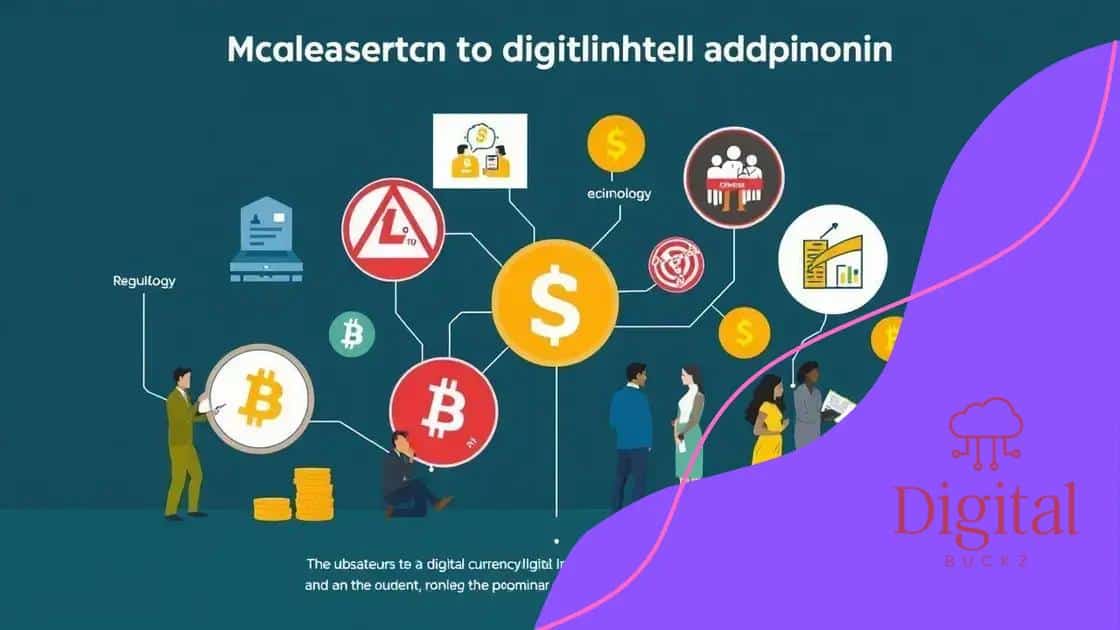The future of financial inclusion through digital currencies

The future of financial inclusion through digital currencies offers innovative solutions that enhance access to financial services for unbanked populations, driven by technologies like mobile payments and blockchain.
The future of financial inclusion through digital currencies is shaping how we interact with money. Have you ever paused to think about how these innovations can transform lives? Let’s explore this dynamic landscape together.
Understanding digital currencies and their potential
Understanding digital currencies is crucial in today’s financial landscape. They represent a shift towards a more inclusive and accessible system. Digital currencies are not just a trend; they are changing how we conduct transactions and interact with money.
One significant aspect is their ability to serve unbanked populations. Many people lack access to traditional banking systems, often due to geographical or economic barriers. Digital currencies allow individuals to participate in the economy without these limitations.
The potential benefits of digital currencies
Digital currencies can offer various advantages that traditional financial systems may not provide. Here are some key benefits:
- Low transaction fees: Digital currencies typically have lower fees than traditional banking transactions.
- Fast transfers: Transactions can occur almost instantaneously, crossing borders without delay.
- Security and privacy: Transactions are recorded on secure ledgers, providing a layer of protection against fraud.
Furthermore, digital currencies enhance financial autonomy. Users control their funds, reducing reliance on banks and intermediaries. This empowerment encourages financial literacy, enabling individuals to make informed decisions about their money.
With the rise of technologies like blockchain, digital currencies are becoming more mainstream. Concepts that seemed complex are now turning into everyday tools. As we delve deeper, it is essential to recognize the potential inherent in these currencies.
Challenges to consider
Despite their advantages, there are challenges. Many people remain unaware of how digital currencies function. Education is vital to ensure that everyone can harness their benefits. Additionally, regulatory landscapes are still developing, impacting adoption rates.
Nonetheless, as more people and institutions explore digital currencies, the possibilities continue to expand. Understanding their potential can help pave the way for a more inclusive financial future.
The role of technology in promoting financial inclusion
The role of technology in promoting financial inclusion is becoming more vital every day. With the rapid rise of digital tools, many are gaining access to financial services previously unavailable to them. Technology is breaking down barriers and creating opportunities.
Mobile banking apps represent one of the most significant innovations. They give people the power to manage their finances from their smartphones, regardless of their location. This is especially important in remote areas where traditional banking infrastructures are lacking.
Key technologies driving financial inclusion
Several technologies are playing a crucial role in expanding access to financial services. These include:
- Blockchain technology: This decentralized ledger improves security and transparency in transactions.
- Big data analytics: This allows financial institutions to assess risk better and tailor products to underserved markets.
- Artificial intelligence: AI helps in automating processes and enhancing customer service, making banking more user-friendly.
In addition to these technologies, social media platforms are also being utilized to spread awareness about financial products. By leveraging these channels, organizations can reach a broader audience and educate them on managing their finances effectively.
Another important aspect is how technology has enabled peer-to-peer lending. This alternative to traditional methods allows individuals to lend money directly to others without the need for intermediaries. It creates a more direct flow of resources and can often offer better rates for both parties.
Challenges and future prospects
While the benefits of technology in promoting financial inclusion are clear, challenges remain. Issues like cybersecurity threats and the digital divide can hinder progress. Some people still lack internet access, limiting their ability to engage in digital finance.
Looking ahead, the potential for further advancements is exciting. As technology continues to evolve, its integration into financial systems will likely expand. This could lead to even more innovative solutions for enhancing financial inclusion, empowering people around the world.
Challenges facing digital currency adoption

Challenges facing digital currency adoption are significant and multifaceted. As digital currencies gain traction, various obstacles must be addressed to ensure their widespread acceptance. Understanding these challenges is key to navigating the future of finance.
One major hurdle is regulatory uncertainty. Different countries have different approaches to governing digital currencies. This inconsistency can confuse users and discourage businesses from embracing these technologies. Without clear regulations, many fear the risks associated with compliance and legal issues.
Technological barriers
Another challenge involves technological barriers. Not everyone has access to the internet or the necessary devices to use digital currencies effectively. This digital divide can prevent certain populations from participating, limiting the potential of inclusive financial systems.
- Security concerns: Cybersecurity is a growing issue. Wallets can be hacked, and lost keys mean lost funds.
- Education and awareness: Many people are unfamiliar with how digital currencies work. This lack of knowledge can keep them from adopting new financial technologies.
- Volatility: The rapid fluctuations in digital currency values can scare off potential users.
Another challenge is the need for infrastructure development. Establishing the networks required to support digital currencies can be costly and time-consuming. Many areas, especially rural ones, need better internet access to fully benefit from these innovations.
Cultural acceptance also plays a role. Some individuals may be hesitant to trust a new form of currency. Building trust will require time and positive experiences with digital transactions. As people see digital currencies functioning well in their communities, they may shift their perceptions.
Future outlook
Despite these challenges, the future of digital currency adoption remains promising. Continuous improvements in technology and increased education efforts are paving the way for acceptance. By addressing these challenges head-on, stakeholders can work towards models that support and enhance financial inclusion effectively.
Case studies of digital currencies improving access
Case studies of digital currencies improving access illustrate their transformative power in various communities. These real-world examples show how digital currencies help people overcome traditional financial barriers.
In countries with limited banking infrastructure, like Kenya, mobile money platforms such as M-Pesa have revolutionized the way individuals manage their finances. Users can send and receive money using their mobile phones, allowing for quick and affordable financial transactions, especially for those in rural areas.
Impact on financial inclusion
These platforms have not only made financial services more accessible but have also increased financial literacy among users. People are learning to save, budget, and even invest using mobile money tools, promoting overall economic well-being.
- Microloans: Some digital currency systems offer microloans to small businesses, providing much-needed capital.
- Remittances: Digital currencies enable lower-cost international remittances, allowing families to support relatives living abroad.
- Access to services: Users can pay bills, buy goods, and receive salaries without needing traditional banking.
Another strong example is in El Salvador, where Bitcoin was adopted as legal tender. This move aimed to integrate a significant portion of the population, especially the unbanked, into the financial system. People can now access services such as loans and investments directly through their smartphones.
However, these case studies also highlight some challenges. While many people have benefited from digital currencies, issues like volatility and lack of regulatory frameworks still pose risks. Continuous education and support are essential for users to navigate these new environments successfully.
Lessons learned
These case studies demonstrate that when implemented thoughtfully, digital currencies can significantly improve access to financial services. They show how technology can bridge the gap for underserved populations, enabling them to participate more fully in the economy.
Future trends in financial inclusion through digital currencies
The future trends in financial inclusion through digital currencies promise significant changes in how people access financial services. As technology continues to evolve, it plays a crucial role in shaping these developments.
One potential trend is the rise of Central Bank Digital Currencies (CBDCs). Governments are considering issuing digital versions of their currencies. This could help ensure that everyone has access to a secure form of money, potentially reducing the number of unbanked individuals.
Integration with existing technologies
Another trend is the integration of digital currencies with existing financial technologies. For example, using blockchain technology can enhance transparency and security in transactions. This integration also facilitates better data sharing among financial institutions, improving service delivery.
- Mobile payment systems: More businesses are adopting mobile payment solutions to make transactions smoother and faster.
- Financial literacy programs: Education initiatives will become essential to teach people how to use digital currencies safely and effectively.
- Smart contracts: These automated contracts can streamline processes and reduce the need for intermediaries, enhancing access to services.
The focus on interoperability will also grow. This means digital currencies from different platforms will be able to work together seamlessly. Users will have a more unified experience, making it easier to transfer funds and use services across various systems.
Moreover, as more people adopt digital currencies, we can expect advancements in user experience design. Simplifying interfaces will make it easier for individuals to engage with digital finance. Companies will aim to create user-friendly platforms that cater to all demographic groups, including the elderly and those with little tech experience.
Addressing security and privacy concerns
Security and privacy will be critical areas of focus. As digital currencies become more popular, developing robust security measures will be essential. Users must feel safe when conducting transactions and storing their assets. Enhancements in encryption and cybersecurity will play a pivotal role in building user trust.
In summary, the future of financial inclusion through digital currencies looks promising. By addressing existing barriers and leveraging technology, we can create a more inclusive financial landscape.
FAQ – Frequently Asked Questions about Financial Inclusion through Digital Currencies
What are digital currencies?
Digital currencies are electronic forms of money that use technology to facilitate transactions, making financial services more accessible.
How do digital currencies promote financial inclusion?
Digital currencies help provide financial services to the unbanked and underbanked populations, allowing them to participate in the economy.
What are some challenges facing the adoption of digital currencies?
Challenges include regulatory uncertainty, security concerns, and the need for greater user education and awareness.
What role does technology play in financial inclusion?
Technology enhances the accessibility and efficiency of financial services, enabling faster transactions and broader reach through mobile and online platforms.






